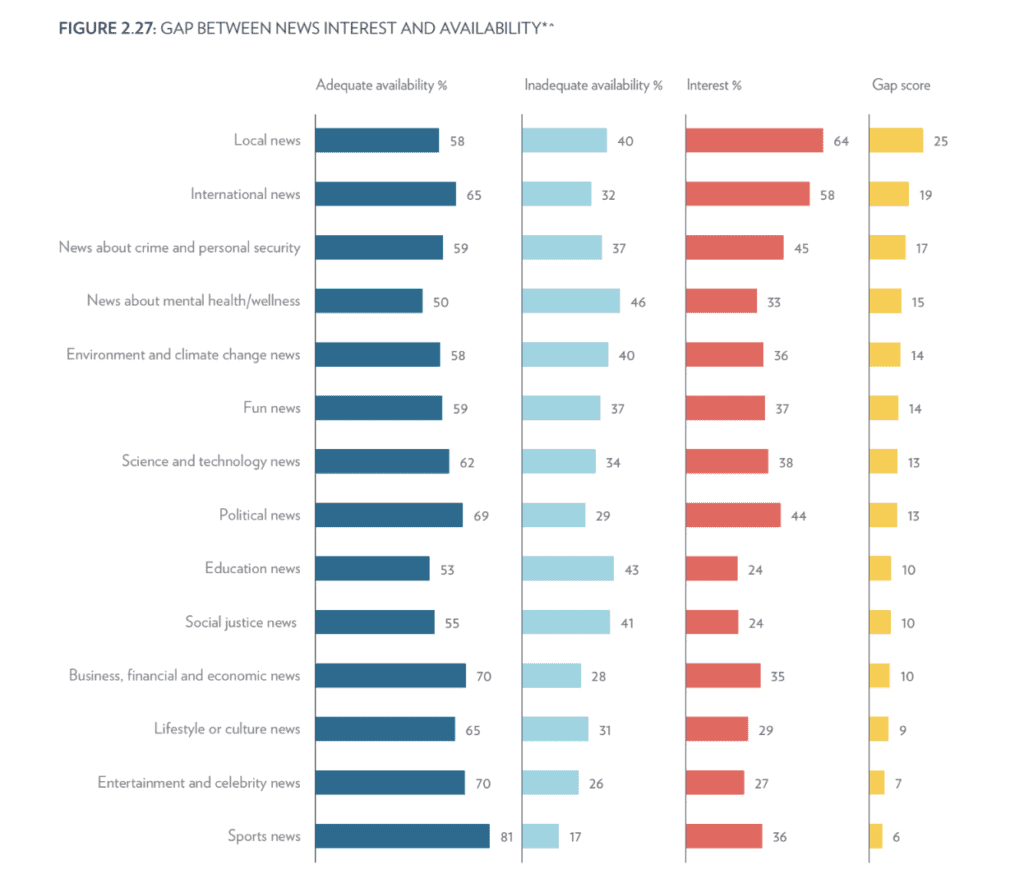Increased concentration within the Australian media landscape and economic pressures on newsrooms have resulted in the syndication of content in local news in regional areas, according to Claire Stuchbery, executive director at The Local and Independent News Association (LIMA).
Speaking on the 2024 Digital News Report – released this week and finding that local news is the most underserved news genre – Stuchbery told Mediaweek that these pressures have also caused fewer journalists to be on the ground covering local news stories across the country.
“It’s not surprising that audiences are left wanting information that’s directly relevant to them – local news,” she said.
“While there are many newsrooms around the country striving to meet that need, it’s a tough space to build a sustainable business model.”
The report found that local news has the biggest gap between availability and audience interest. Researchers compared the gap between audience interest in news topics and the proportion of people who say there is adequate availability of news on that topic.
The results saw local news emerge as the most under-served news genre, with an availability gap score of 25, followed by international news at 21, and news about crime and personal security at 19.
To close the gap, Stuchbery says LINA helps support existing newsrooms to provide the local news audiences’ needs and wants, and to help emerging newsrooms get established.
“There is significant opportunity in this space to respond to the news needs of audiences across Australia, but we’re finding publishers really struggle to do it alone, so it takes organisations like LINA and others, in partnership with the philanthropic sector, government and state and national news providers to meet that gap and ensure the news ecosystem as a whole is serving communities well.”

According to the report, created by the University of Canberra and Reuters Institute, regional consumers are less likely to believe that the news media are doing a good job performing the various roles than people living in metropolitan areas.
Regional respondents were less likely to say the news is doing a good job at delivering news that makes them feel connected to others in society. Only 26% said news makes them feel better about the world, much lower than city dwellers (43% and 36%, respectively).
Writing in the report, Karen Percy, federal president, media section at the Media Entertainment and Arts Alliance, said the “public” needs to be put back into public interest in journalism.
“Audiences are once again declining. So too is trust in the media,” she said.
“If we are to slow or even reverse this, we must listen to our audiences – even then they are telling us things we don’t want to hear.
“The pressures on day-to-day news journalists are intense as they navigate a 24/7 news cycle, the constant threat of job cuts, filing across platforms, and the outsized role of social media.
“Many of the editorial decisions that upset viewers or readers or listeners are not made by rank-and-file journalists. They are made by the higher-ups based on clicks or commercial considerations.
“The answer is in reaffirming public interest, ethical journalism with appropriate checks and balances. The answer is in better-resourced newsrooms with a focus on quality and accuracy, and support for journalists. The answer is in slowing down, getting the story right, checking, then checking again. The answer is in thinking about what the audience needs and wants from us—not peddling outrage, partisanship, and confected conflict. The answer is in diversifying newsrooms so they reflect and represent the contemporary Australian public the audiences—they seek to serve.”
